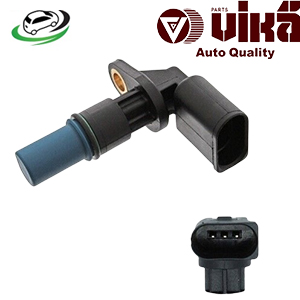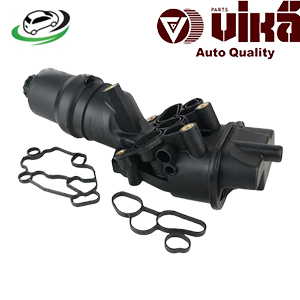-4%
Get AUDI A3 (8P1)/ A3 Sportback / VW EOS (1F7 1F8)/ Golf V (1K1)/ Jetta III (1K2)/ Passat B6 (3C2)/ Touran (1T1 1T2) Oil Filter Assembly 06D115397J
The oil filter assembly is an essential component of an internal combustion engine, designed to filter out contaminants from the engine oil and ensure that the oil circulating in the engine is clean and effective. By keeping the oil free from debris, the oil filter helps protect the engine’s internal parts from wear and tear, prolongs engine life, and ensures smooth engine performance.
In this detailed guide, we will explore the role of the oil filter assembly, how it works, its benefits, common problems, and maintenance practices to keep it functioning optimally.
1. What is the Oil Filter Assembly?
The oil filter assembly is a complete system that includes the oil filter, a housing or casing, a mounting base, and in some cases, valves or additional components to regulate the flow of oil. This assembly is attached to the engine block and works to clean engine oil as it circulates through the lubrication system.
The oil filter assembly includes the following key components:
- Filter Media: The filter element inside the oil filter is usually made of synthetic fibers, cellulose, or a combination of both. This media is responsible for trapping contaminants like dirt, metal particles, and carbon deposits while allowing clean oil to pass through.
- Oil Filter Housing: The housing is the outer casing that protects the filter media and keeps the oil contained. It can be made of metal or durable plastic. In some vehicles, this housing is a separate part, while in others, the oil filter itself is a replaceable cartridge.
- Bypass Valve: The bypass valve is an important part of the oil filter assembly, designed to allow oil to bypass the filter if it becomes clogged or if the oil is too thick (like during a cold start). This ensures that the engine always receives oil, even if the filter is blocked.
- Anti-Drain Back Valve: In some oil filter assemblies, particularly those used in modern vehicles, there is an anti-drain back valve that prevents oil from draining out of the filter when the engine is turned off. This keeps the filter full of oil and helps prevent dry starts, which could cause engine damage.
2. Functions of the Oil Filter Assembly
The oil filter assembly serves several vital functions to ensure the longevity and efficiency of the engine. These include:
- Filtering Contaminants: As engine oil circulates through the engine, it picks up contaminants such as dirt, metallic particles from engine wear, carbon deposits, and other debris. The filter captures these particles before they can re-enter the engine, ensuring that only clean oil reaches the engine’s moving parts.
- Ensuring Proper Lubrication: Engine oil provides essential lubrication to the engine’s components, reducing friction and preventing overheating. The oil filter assembly ensures that this oil is clean and capable of lubricating the engine effectively. Without proper filtration, contaminated oil can cause engine wear and damage.
- Maintaining Oil Pressure: The oil filter assembly plays a role in regulating oil pressure. A clogged filter can restrict oil flow and lead to a drop in oil pressure, which can damage the engine. The bypass valve helps maintain pressure by allowing oil to continue circulating, even if the filter is clogged.
- Preventing Oil Contamination Recirculation: Over time, contaminants in the oil can lead to sludge buildup within the engine. The oil filter assembly prevents these contaminants from circulating back into the engine, which can contribute to engine wear, decreased efficiency, and in severe cases, engine failure.
3. Benefits of a Well-Maintained Oil Filter Assembly
A properly functioning oil filter assembly offers numerous benefits to the engine and the overall performance of the vehicle. These benefits include:
- Prolongs Engine Life: The oil filter assembly helps reduce engine wear by ensuring that clean oil is delivered to all parts of the engine. This reduces friction between moving parts and prevents damage caused by contaminants, extending the life of the engine.
- Improves Engine Performance: Clean oil ensures that the engine runs smoothly and efficiently. Without proper filtration, contaminants in the oil can increase friction and reduce the engine’s performance. A well-maintained oil filter ensures optimal engine power, fuel efficiency, and smooth operation.
- Reduces Engine Emissions: Contaminated oil can affect the combustion process, leading to increased emissions. By keeping the oil clean, the oil filter assembly helps the engine burn fuel more cleanly, reducing harmful exhaust emissions and helping the vehicle meet environmental regulations.
- Prevents Costly Repairs: By filtering out debris and contaminants, the oil filter assembly helps prevent engine damage that could require expensive repairs or even a complete engine replacement. Regular oil filter maintenance is a simple and cost-effective way to avoid major engine problems.
- Ensures Proper Oil Flow: The oil filter assembly ensures a steady flow of oil throughout the engine, even in extreme temperatures or under high engine loads. This helps prevent oil starvation and keeps the engine components properly lubricated at all times.
4. Common Problems with Oil Filter Assemblies
Despite their durability, oil filter assemblies can experience issues over time. Some common problems include:
- Clogged Filter: Over time, the filter media becomes saturated with contaminants, which can restrict the flow of oil. A clogged filter can lead to low oil pressure, poor engine performance, and potential engine damage. This is why it’s important to change the oil filter at regular intervals.
- Bypass Valve Failure: If the bypass valve in the oil filter assembly fails, it can either prevent oil from flowing when the filter is clogged or allow unfiltered oil to circulate even when the filter is clean. This can result in engine wear from unfiltered oil or oil starvation if the valve doesn’t open when needed.
- Oil Leaks: The oil filter assembly can develop leaks due to a damaged housing, improper installation, or worn-out seals. Oil leaks can lead to low oil levels, reduced oil pressure, and, in severe cases, engine damage. Leaks around the oil filter should be addressed immediately.
- Faulty Anti-Drain Back Valve: If the anti-drain back valve fails, oil may drain out of the filter when the engine is turned off. This can cause a “dry start” when the engine is restarted, leading to increased engine wear.
5. Signs of a Faulty Oil Filter Assembly
A malfunctioning oil filter assembly can cause several noticeable symptoms in the vehicle, including:
- Low Oil Pressure Warning Light: If the oil filter becomes clogged, it can restrict oil flow and cause a drop in oil pressure. Many vehicles are equipped with an oil pressure warning light that will illuminate if the pressure falls below a certain level.
- Engine Overheating: Without proper oil flow, the engine may overheat due to increased friction between moving parts. If the engine temperature rises unexpectedly, a clogged oil filter could be the cause.
- Dirty or Contaminated Oil: If the oil filter is not working correctly, contaminants may not be properly removed from the oil. This can result in dirty, sludge-like oil that appears darker than usual during an oil change.
- Engine Noise: A lack of proper lubrication due to a faulty oil filter assembly can lead to increased friction in the engine, which may cause unusual engine noises, such as knocking or grinding sounds.
6. Maintenance Tips for Oil Filter Assemblies
Maintaining the oil filter assembly is a straightforward yet essential task to ensure engine health and longevity. Here are some key maintenance tips:
- Regular Oil and Filter Changes: Changing the oil and oil filter at the recommended intervals is one of the most important steps in maintaining the oil filter assembly. Most manufacturers recommend changing the oil filter every time the oil is changed, typically every 5,000 to 10,000 miles, depending on driving conditions.
- Inspect for Leaks: During routine maintenance, inspect the oil filter and its housing for any signs of leaks. If you notice oil around the filter, tighten the filter or replace the seals as necessary.
- Use the Correct Filter: Always use the correct type of oil filter for your vehicle as specified by the manufacturer. Using an incorrect filter may result in poor filtration, leaks, or improper fitment, which could lead to engine damage.
- Monitor Oil Pressure: Keep an eye on the vehicle’s oil pressure gauge or warning light. A sudden drop in oil pressure could indicate a clogged filter or a problem with the oil filter assembly.
- Check the Bypass and Anti-Drain Back Valves: If your vehicle’s oil filter assembly includes a bypass valve or anti-drain back valve, ensure these components are functioning properly to prevent oil flow issues.
7. Conclusion
The oil filter assembly is a crucial part of the engine’s lubrication system, ensuring that clean oil reaches all moving parts of the engine. By filtering out contaminants, the oil filter helps prolong engine life, improve performance, and prevent costly repairs. Regular maintenance, including oil and filter changes, inspections for leaks, and using the correct filter, can help keep the oil filter assembly functioning optimally and ensure the longevity of the engine.
Follow us on Facebook for more parts.




Reviews
Clear filtersThere are no reviews yet.